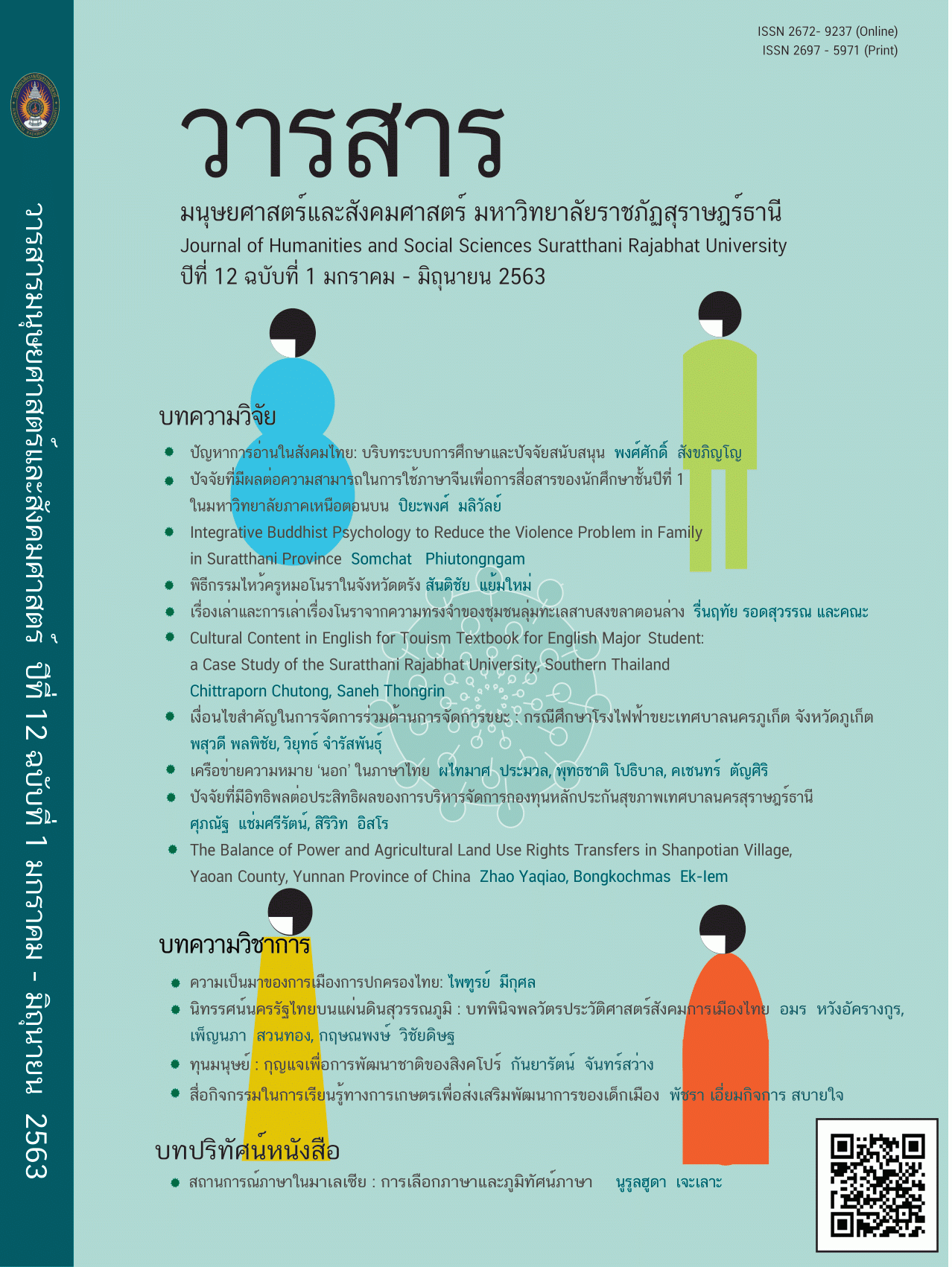Narrative and Narration of Nora from Memories of Communities in the Lower Songkhla Lake Basin
Main Article Content
Abstract
The objectives of this research were to study the narratives of Nora to present narrative printings of Nora from the memories of people living in the communities in the Lower Songkhla Lake Basin. In this qualitative
research, the field data were mainly gathered in two communities—Tha Jeen Community and Wat Ku Tao Community—in the Lower Songkhla Lake Basin from the 3 main group, a total of 58 people, through observation,
interview, and participatory mappings. The concepts used to analyze the data was narratives and collective memories, together with Nora paintings through the concept of creative painting. The research findings indicated that the narratives of Nora from the memories of people in Tha Jeen
Community had relationships with a belief called Tuad (great-grandparents) while the narratives told by people in Wat Ku Tao Community were Nora Competition (Nora Prachan Rong), which was mainly aimed at entertainment. When these two narratives were analyzed and compared, it reflected that Nora was performed according to their beliefs and ceremonies happening in people’s everyday life; therefore, Nora performances are sustainable rather than only for entertainment. In addition, the memories of Nora narrative paintings have been applied to record concrete memories of people living in the Lower Songkhla Lake Basin onwards.
Article Details

This work is licensed under a Creative Commons Attribution-NonCommercial-NoDerivatives 4.0 International License.
All published manuscripts have been verified by peer-peer professors in the fields of humanities and social sciences. Reprinting of the article must be authorized by the editorial staff.
References
ฉัตรชัย ศุกระกาญจน์. (2523). พิธีกรรมที่น่าศึกษาในโนราโรงครู. พุ่มเทวา ที่ระลึกงาน
เชิดชูเกียรติศิลปินภาคใต้ : ขุนอุปถัมภ์นรากร. 111-125.
ชวน เพชรแก้ว. (2540). ทีทรรศน์วัฒนธรรม รวมบทความทางวิชาการวัฒนธรรมศึกษา.
กรุงเทพฯ: อมรินทร์พริ้นติ้ง.
ประหยัด เกษม. (2523). การแสดงโนราจากอดีตถึงปัจจุบัน. พุ่มเทวา ที่ระลึกงานเชิดชู
เกียรติศิลปินภาคใต้ : ขุนอุปถัมภ์นรากร. 126-138.
พิทยา บุษรารัตน์. (2546). รายงานการวิจัยเรื่อง การแสดงพื้นบ้าน : การเปลี่ยนและ
ความสัมพันธ์กับสังคมและวัฒนธรรมบริเวณลุ่มทะเลสาบสงขลา กรณีศึกษา
หนังตะลุงและโนราช่วงการปฏิรูปการปกครองสมัยรัชกาลที่ 5 ถึงปัจจุบัน.
สงขลา : สถาบันทักษิณคี มหาวิทยาลัยทักษิณ.
รื่นฤทัย รอดสุวรรณ. (2559). สถานภาพงานวิจัยโนราในรอบสามทศวรรษ (พ.ศ.2532-
. เอกสารประกอบการประชุม รัฐ คนไท/ไทย ชายแดน และทิศทางใหม่ๆ
ในไทยศึกษา งานประชุมวิชาการประจำปี 2559. 2559(1), 362-376.
สมเกียรติ ตั้งนโม. (2559.) ศิลปะในสายตาสังคมวิทยา บทความลำดับที่
สังคมวิทยาศิลปะ. [ออนไลน์]. เข้าถึงได้จาก http : //www1.midnight
univ.org/fineartcmu2001/newpage4.htm. [2559, กันยายน 10].
สิงหนาท แสงสีหนาท. (2548). ศูนย์กลางชุมชนกับวัฒนธรรมความยั่งยืน กรณีศึกษา
ชุมชนไทใต้คง ประเทศสาธารณรัฐประชาชนจีน. หน้าจั่ว. 25-32.
บุคลานุกรม
ใบเดาะ สุวรรณสาม (ผู้ให้สัมภาษณ์). รื่นฤทัย รอดสุวรรณ (ผู้สัมภาษณ์). ที่บ้านเลขที่
/1 หมู่ 7 ตำบลคูเต่า อำเภอหาดใหญ่ จังหวัดสงขลา. เมื่อวันที่ 13
พฤศจิกายน 2561.
เปลื้อง สุขสวัสดิ์ (ผู้ให้สัมภาษณ์). รื่นฤทัย รอดสุวรรณ (ผู้สัมภาษณ์). ที่วัดคูเต่า หมู่ 3
ตำบลแม่ทอม อำเภอหาดใหญ่ จังหวัดสงขลา. เมื่อวันที่ 22 กรกฎาคม 2560.
ผ่อง แก้วสามกูล (ผู้ให้สัมภาษณ์). รื่นฤทัย รอดสุวรรณ (ผู้สัมภาษณ์). หมู่ที่ 7 ตำบล
น้ำน้อย อำเภอหาดใหญ่ จังหวัดสงขลา. เมื่อวันที่ 1 กันยายน 2559.
วัน รัตนชัย (ผู้ให้สัมภาษณ์). รื่นฤทัย รอดสุวรรณ (ผู้สัมภาษณ์). ที่วัดคูเต่า หมู่ 3 ตำบล
แม่ทอม 1 มีนาคม 2559.
อินแก้ว ทองสมสี (ผู้ให้สัมภาษณ์). รื่นฤทัย รอดสุวรรณ (ผู้สัมภาษณ์). ที่บ้านเลขที่ 52
หมู่ที่ 1 ตำบลท่าข้าม อำเภอหาดใหญ่ จังหวัดสงขลา. เมื่อวันที่ 1 กันยายน


